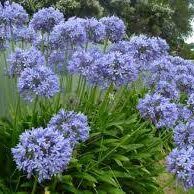Agapanthus Treatment Tips for Lush and Vibrant Flowers
Agapanthus Treatment Tips for Lush and Vibrant Flowers
Blog Article
Grasping the Art of Agapanthus Care: Vital Actions for Healthy And Balanced Development and Vivid Flowers
In the realm of cultivation, the cultivation of agapanthus stands as a gratifying endeavor for those who seek to nurture these elegant flowering plants. With their striking flowers and stylish foliage, agapanthus has caught the attention of garden enthusiasts worldwide. However, attaining optimal development and vivid blooms needs a nuanced approach that includes different vital steps. From selecting the appropriate variety to understanding trimming strategies, the journey towards growing growing agapanthus plants is diverse and holds the key to unlocking the full capacity of these agricultural treasures.

Picking the Right Agapanthus Variety

When selecting the best Agapanthus selection for your yard, think about aspects such as climate viability, flower shade, and development behavior. Furthermore, take into consideration the climate in your region to make sure the Agapanthus range you select can thrive in your particular conditions. Comprehending the growth routine of various Agapanthus selections is essential for proper placement within your garden.
Ideal Growing Conditions
Thinking about the optimal ecological needs is important for effective Agapanthus farming. Agapanthus grows in well-draining soil with a somewhat acidic to neutral pH level. When planting, pick a place that gets complete sunshine to partial color. In hotter environments, supplying some mid-day color can stop scorching of the leaves. Agapanthus plants are delicate to cool temperatures and must be protected from frost during winter months.
To guarantee healthy growth and vibrant blooms, plant Agapanthus bulbs at a deepness of regarding 2-4 inches and area them 8-12 inches apart. Adding raw material, such as garden compost, to the dirt can boost drain and fertility, promoting robust root development. Mulching around the base of the plants helps preserve dampness and reduces weed growth. Regular watering is crucial, particularly during the growing season, to maintain the dirt continually wet yet not waterlogged.
Watering and Feeding Tips
Maintaining correct moisture levels and providing necessary nutrients are vital components in the treatment program for Agapanthus plants. When it comes to sprinkling Agapanthus, it is essential to strike a balance. These plants favor constantly damp soil yet are vulnerable to root rot if overwatered.
Fertilizing Agapanthus is vital for advertising healthy and balanced growth and respected flowers. Apply a balanced plant food, such as a 10-10-10 formula, in the early springtime as new growth arises. Repeat this application every 6-8 weeks throughout the growing period. Prevent too much fertilization, as it can cause rich vegetation at the cost of blooms. Always adhere to the maker's instructions for correct dilution and application methods. By adhering to these watering and fertilizing pointers, you can guarantee your Agapanthus plants thrive and create lively, long-lasting flowers.
Pruning Methods for Agapanthus
Pruning Agapanthus plants at the appropriate times and with appropriate methods is important for preserving their wellness and advertising optimal growth and flowering. The perfect time to trim Agapanthus is in late winter or very early spring prior to brand-new development arises.
Deadheading invested blossoms can also reroute the plant's power into generating more flowers rather than setting seeds. If you desire to collect seeds for proliferation, leave some flowers to mature and completely dry on the plant.
Remember to use clean, sharp devices to make specific cuts and minimize the threat of introducing conditions. Agapanthus. Normal pruning will certainly assist keep your Agapanthus looking cool and healthy while ensuring a plentiful display screen of attractive flowers
Taking Care Of Common Pests and Diseases
After guaranteeing appropriate trimming strategies for Agapanthus, it is vital to deal with typical bugs and illness that can affect the health and wellness and vigor of these plants. One typical pest that click to read more influences Agapanthus is the Agapanthus gall midget.
In addition, Agapanthus plants can experience from root rot if they are planted in badly draining pipes dirt. By being watchful and taking punctual action versus diseases and pests, you can help your Agapanthus plants grow and generate dynamic blooms. Agapanthus.

Final Thought
In final thought, understanding the art of agapanthus care entails choosing the right variety, giving excellent growing conditions, proper watering and feeding, ideal trimming strategies, and addressing typical pests and conditions. By following these vital actions, you can make sure healthy and balanced growth and dynamic flowers for your agapanthus plants. Remember to frequently keep visite site track of and keep your plants to promote their total well-being and long life.
To make certain healthy and balanced development and dynamic blossoms, plant Agapanthus light bulbs at a deepness of concerning 2-4 inches and space them 8-12 inches apart. By complying with these watering and fertilizing pointers, you can guarantee your Agapanthus plants thrive and generate browse around this site vibrant, lasting blooms.
One typical bug that influences Agapanthus is the Agapanthus gall midge. Furthermore, Agapanthus plants can endure from origin rot if they are grown in inadequately draining soil. By following these necessary actions, you can make sure healthy and balanced development and dynamic flowers for your agapanthus plants.
Report this page